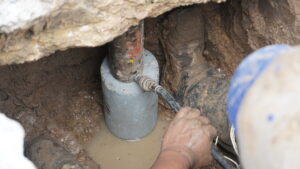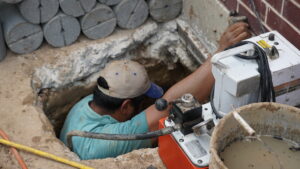The Durability Of Polyurethane Foam for Concrete Leveling
Cracked or uneven concrete tends to leave homeowners scratching their heads about the best course of action. Whether it’s a sinking driveway or an uneven patio slab, fixing these issues can be a top priority.
One increasingly popular solution is polyurethane foam for concrete leveling. But is it durable enough to stand the test of time? If you’re considering this option, here’s what you need to know about its longevity and why it’s gaining traction as a reliable fix.
What Is Polyurethane Foam Concrete Leveling?
Polyurethane foam leveling, sometimes referred to as foam jacking, is a process where a specialized foam is injected under sinking concrete slabs. The foam expands and lifts the slab back to its original position. Unlike traditional mudjacking, which uses heavy slurry, polyurethane foam is lighter and quicker to apply. The process addresses foundation problems effectively, making it ideal for walkways, driveways, patios, and even garage floors.
How Does Polyurethane Foam Work?
This cutting-edge method starts with small holes being drilled into the affected concrete. A foam mixture is injected through these holes, filling voids beneath the slab. The foam reacts and expands rapidly, providing the lift needed to level the surface. Once cured, the material hardens and stabilizes the concrete above it.
While this sounds straightforward, many homeowners wonder about its staying power. After all, no one wants to revisit the same project years down the line.
The Durability of Polyurethane Foam
When investing in home repairs, durability is often the biggest concern. Is polyurethane foam a “set it and forget it” solution, or does it require regular maintenance? Here are the key factors that determine its lifespan:
Resistance to Weight and Pressure
Polyurethane foam is remarkably strong. Though lightweight during application, once it sets, it can handle impressive loads. This makes it suitable for driveways where vehicles frequently park and walkways with heavy foot traffic. Homeowners can rest assured that the foam provides a stable foundation for everyday use.
Moisture Resistance
One of the most significant advantages of polyurethane foam is its ability to resist water. Traditional concrete leveling methods often erode over time when exposed to water or freeze-thaw cycles. Polyurethane foam, however, creates a barrier that doesn’t easily absorb moisture. This moisture resistance helps it maintain its structure even in regions with wet or harsh climates.
Long-Lasting Material
Polyurethane foam is not prone to breaking down, even after years of use. When applied correctly by professionals, it adheres securely under the slab, maintaining stability for decades. Of course, factors like the condition of the ground beneath the slab and the quality of the installation can impact its lifespan.
Eco-Friendliness and Minimal Land Impact
Unlike traditional mudjacking, polyurethane foam minimizes disruption to the surrounding land. With smaller injection holes and a lighter footprint, the process ensures the surrounding ground remains intact. This contributes to the foam’s lasting effectiveness by reducing additional settlement risks in the soil.
Comparing Polyurethane Foam to Traditional Methods
To appreciate the durability of polyurethane foam, it helps to compare it to other methods, like mudjacking.
Weight
Traditional mudjacking uses heavy slurry, which can weigh down compromised soil further. Polyurethane foam is much lighter, reducing the risk of additional settlement over time.
Longevity
While both methods can last for several years, polyurethane foam often outperforms mudjacking in retaining its effectiveness. The foam’s rigid properties minimize the chances of repeat sinking.
Time Efficiency
Foam leveling cures in minutes, allowing the concrete to be used almost immediately. Mudjacking generally requires longer drying times, which can delay usage and sometimes compromise results.
Maintenance
Polyurethane foam typically doesn’t require follow-up maintenance if the initial application is done correctly. Meanwhile, mudjacking may not be as enduring and could demand repairs in certain cases.
Key Considerations for Homeowners
While polyurethane foam boasts impressive durability, no solution is one-size-fits-all. Before making a decision, homeowners should assess a few important factors.
Ground Conditions
Polyurethane foam works best when the underlying soil is relatively stable. If the ground beneath the slab is highly prone to shifting, additional steps may be needed to reinforce the area.
Installation Expertise
The longevity of polyurethane foam depends heavily on the quality of the installation. Choosing experienced professionals is a crucial step in ensuring the foam is applied correctly. Improperly placed foam can lead to uneven results or premature failure.
Specific Application Needs
The foam is versatile, but some surfaces like those exposed to extreme weight or movement—may require tailored solutions. Discussing these situations with a professional can help identify potential risks and solutions.
Cost Considerations
Polyurethane foam can initially cost more than mudjacking. However, its longer lifespan and reduced need for upkeep often make it the more cost-effective choice in the long run.
Real-Life Results
Homeowners across the country are seeing success with polyurethane. Here’s an example:
A homeowner had a sinking driveway due to years of soil erosion. After opting for foam leveling, their driveway was restored within a few hours. Five years later, the intersection remains perfectly level, despite heavy snow and freeze-thaw conditions each winter. This type of outcome is becoming increasingly common and is a strong testament to the foam’s staying power.
Making the Right Choice for Your Home
If you’re considering polyurethane foam for concrete leveling, its durability makes it a highly attractive option. From its water resistance to its ability to handle heavy loads, this solution checks many boxes for modern homeowners. Combine that with professional installation and stable ground conditions, and you have a fix designed to stand up to years of daily use.
When it comes to protecting your investment and restoring functionality to your concrete surfaces, polyurethane foam is a top contender. Always consult with trusted experts to determine if it’s the ideal fit for your home’s specific needs.

